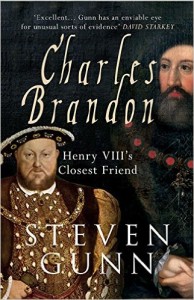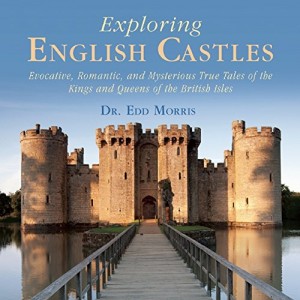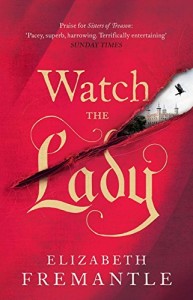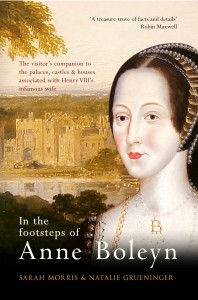Charles Brandon: Henry VIII’s Closest Friend by Steven Gunn
This academic study of Charles Brandon (grandfather of Lady Jane Grey) is a new version of Steven Gunn’s earlier biography of the closest friend of Henry VIII.
Gunn has pieced together a tremendously detailed picture of the Duke of Suffolk through evidence of the costumes he and Henry VIII wore for tournaments, the estates granted to him, income, debts, local rivalry with the Duke of Norfolk and Charles’s complex marital history.
Charles kept his friendship with Henry VIII, weathering the storms of his marriage to Henry’s sister, Mary (former Queen of France), military challenges and Henry’s divorce from Catherine of Aragon and subsequent marriages.
As an academic biography, it is not an easy read. While the level of detail is fascinating in some places, in others it makes the book very slow going. I would have liked more information about his marriage to Mary Tudor and translations of the French and Latin quotes would have been helpful.
Exploring English Castles: Evocative, Romantic, and Mysterious True Tales of the Kings and Queens of the British Isles by Edd Morris
This fascinating book by Edd Morris starts off with a brief history of the castle: from the Norman invasion of 1066, the motte and bailey, the development of the medieval castle to their decline.
He then looks at nine castles in great detail (Bodiam, Corfe, Dover, Dunstanburgh, Framlingham, Goodrich, Kenilworth, Rochester and Tintagel). For each castle there is a floor plan, lots of amazing photos, a brief history of the castle and notes on any curious features, such as the chimney pots at Framlingham. But what really brings each castle to life is how Morris takes ‘a snapshot of one of the most notable moments in the past.’
For those interested in Tudor history, the notable events at Framlingham and Kenilworth involve the Tudor Queens, Mary I and Elizabeth I. Through the inclusion of Framlingham, this book also has links to Lady Jane Grey, as Framlingham Castle was where Mary Tudor raised her standard against Queen Jane in July 1553.
Read this book before visiting any of the castles included!
Watch The Lady by Elizabeth Fremantle
‘Watch The Lady’ plunges you back into life at the Tudor court, so magnificently depicted by Elizabeth Freemantle in ‘Queen’s Gambit’ and ‘Sisters of Treason.’ Mainly set in the last years of Elizabeth I’s reign, with all the tension of a dying dynasty, we meet Penelope Deveraux, who is forced to marry a man she does not love. Penelope must negotiate life at court, trying to avoid the fate of her mother (who dared to marry the Queen’s favourite), while supporting her brother, the Earl of Essex, as he plays his deadly game with his rival, Robert Cecil. ‘Watch The Lady’ is a fitting end to Fremantle’s fabulous Tudor trilogy.
In the Footsteps of Anne Boleyn by Sarah Morris & Natalie Grueninger
‘In the Footsteps of Anne Boleyn’ is the perfect companion for those wanting to visit places linked to Henry VIII’s second wife. As well as covering the well-known locations such as The Tower of London and Hever Castle, you can also follow Anne on the royal progress she made with Henry in 1535.
For each location the authors have included its history, how it links to Anne, what remains of the place today and important visitor information. The treasure trove section is a wonderful bonus. It is fascinating to find out about items belonging to or relating to Anne that have survived, even though hardly any are on public display.
Thanks to this book, I have already had a very enjoyable trip to The Vyne, a place I never knew had links to Anne and look forward to planning many more.
By following in the footsteps of Anne, you can also follow in those of Lady Jane Grey. Jane also had links to a number of the places mentioned: Tower of London, Durham House, Sudeley Castle and Palace of Beaulieu (New Hall). The church where Jane’s mother was christened is also mentioned.
I would say that the only thing missing from this book is an index.
Tudor: The Family Story by Leanda de Lisle
Two years ago I was lucky enough to read an early draft of the first few chapters of what became ‘Tudor: The Family Story’ by Leanda de Lisle. It was a long wait until the finished book was sent to me to review, but it was well worth it. This is de Lisle’s best work yet.
What makes this different to other books about the Tudors is that de Lisle strips away the layers of politics to reveal the personalities of the Tudor monarchs and the extended royal family and the constant battle to secure the throne. The level of detail throughout is superb and the revelations about well-known events makes you stop and consider them from a different perspective.
‘Tudor’ takes you from the beginning of the dynasty with the marriage of Catherine of Valois to Owen Tudor, the birth of Henry Tudor to the 13 year old Margaret Beaufort, through the Wars of the Roses, the Battle of Bosworth, the reigns of Henry VII, Henry VIII and Edward VI and their struggle to secure the succession, the nine days reign of Lady Jane Grey, Queen Mary’s fight to win her throne to become the first Queen of England and the long reign of the last Tudor monarch, Elizabeth I. Throughout these events some of the lesser known members of the royal family tree are allowed to take centre stage and their full role in proceedings is revealed.
After de Lisle’s excellent ‘The Sisters Who Would Be Queen: The Tragedy of Mary, Katherine and Lady Jane Grey’, I didn’t know if there would be any new revelations regarding the nine days queen but again de Lisle has managed it. ‘Tudor’ examines the relationship between Jane and Guildford and questions the truth about the events of Jane’s reign. Two of the topics of the five appendices relate to Lady Jane. Appendix 3 is about Jane and her husband (‘Guildford and Jane Dudley’) and Appendix 4 is about Jane’s mother (The Myth of Frances Brandon the Child Abuser).
‘Tudor: the Family Story’ is quite simply a ‘must read!’
The Sisters Who Would Be Queen: The Tragedy of Mary, Katherine and Lady Jane Grey by Leanda de Lisle
Leanda de Lisle writes that when starting her research, `she suspected there would be little new to say about Jane herself’ (p314), but by revisiting contemporary sources found that this was not the case.
In this extremely readable account of the lives of the three Grey sisters, de Lisle challenges the traditional view that Jane was born at Bradgate in October 1537 (the same month as Prince Edward) and also Jane’s relationship with her mother Frances, Duchess of Suffolk.
The author puts forward a new argument supporting David Starkey’s identification of the Teerlinc miniature.
A more `human’ Jane is presented than the Protestant martyr of previous biographies, whilst not diminishing her religious faith or acceptance of her role.
Her sisters, Catherine and Mary, are allowed to emerge from the shadow of their more well known sister, the nine day queen. The book includes a previously unpublished part of a letter between Catherine and her husband and a forgotten document relating to Mary.
De Lisle reinstates the importance of Catherine Grey and the possible alternate royal dynasty that were an ongoing threat to Elizabeth I. She also shows how Mary followed in Catherine’s footsteps and how the lives of all three sisters were blighted by their closeness to the throne.
`The Sisters Who Would Be Queen’ is a must read for anyone interested in Jane, Catherine and Mary Grey.








































